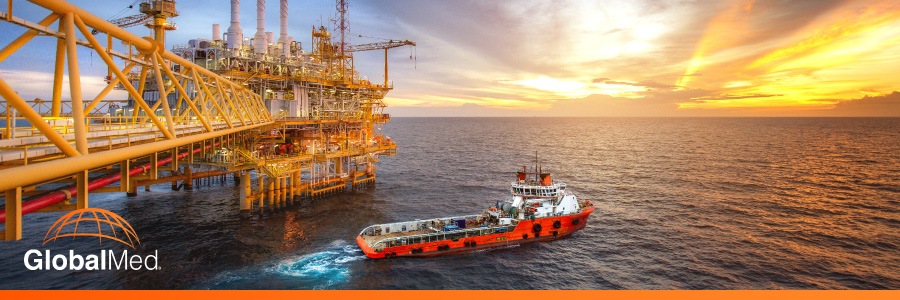
If I told you oil and gas companies are one of the oldest telemedicine markets, would you be surprised? You shouldn’t be. While virtual care is still cutting-edge in some workplaces, high-risk industries have always looked for ways to protect their employees. Oil and gas leaders have used telehealth – first through telephonic visits, then video calls, now evidence-based virtual care – to safeguard their workers’ health and safety for decades.
Petroleum and mining crews can encounter danger on the job in several ways:
- Large offshore oil reservoirs mean that saturation divers often do underwater construction and demolition work at depths of 1000 feet or more – sometimes for weeks at a time. Lately mining companies have used tankers to comb the ocean floor for diamonds.
- Crews can work and live on platforms a hundred or more miles/kilometers from land – and the nearest hospital.
- Mining and fracking in rural locations can expose employees to explosives, hearing problems, asphyxiation from gases and respiratory problems from coal dust.
- Whether working on water or land, employees may face injury from accidents involving heavy equipment.
To keep employees and contractors safe, these companies adopt intense protocols and innovative care delivery methods like telemedicine. But the benefits extend far beyond safety.
From Faster Care to Cost Savings
Oil, gas and mining workers can face the same illnesses as anyone else, such as ear infections, allergic reactions or pancreatitis. But divers face unique occupational hazards. Working deep in the ocean means they breathe pressurized air, with inert gases like nitrogen dissolving into their bodies. Because that gas will explode inside them at the surface, causing decompression sickness (known as “the bends”), they spend considerable time in decompression chambers. Telemedicine stations in those chambers can connect solitary divers to clinicians to discuss joint pain, shortness of breath and other symptoms, rather than suffering alone.
On an oil platform or mining ship, a work injury or emergency like a cardiac event can require transport off the platform. Telemedicine can help here too, both in connecting patients to immediate specialty care and by helping the employer avoid the cost of unnecessary flights. While scheduled flights to the mainland are built into the company’s expected costs, emergency non-scheduled flights to a hospital emergency department can cost thousands of dollars while putting the crew at risk during turbulent weather. Yet employees may have grounds for a lawsuit if they’re not transported to mainland care. Using telemedicine, providers can conduct a clinical patient evaluation and accurately determine the need for evacuation.
That evaluation also helps oil, gas and mining leaders avoid recordable OSHA incidents – something that can impact the company financially. For instance, the difference between a patient receiving first aid like a butterfly bandage (non-recordable) versus requiring stitches (recordable) can determine whether or not a laceration needs to be added to a company’s OSHA log. Virtual care can help providers receive second opinions and avoid creating unnecessary recordables.
Driving Value with Virtual Health
Brazilian petroleum giant Petrobras is one company that successfully uses telemedicine to care for their offshore oil production workers while saving money. Urgent care nurses worked on the oil platform, but they couldn’t always diagnose or judge the acuity of the problem – which meant any illness or injury could involve a costly and risky helicopter evacuation to a mainland hospital. Using GlobalMed solutions, Petrobras launched a telemedicine program in collaboration with Hospital Israelita Albert Einstein, a teaching hospital in Sao Paolo.
In one year, the hospital conducted 965 telemedicine visits between urgent care nurses on the production platforms and physicians at the hospital. The results:
- 2 of those visits led to patient discharge – potentially avoiding a helicopter evacuations that could cost roughly R$10,000-R$15,000 Brazilian reals, or $2500-$3750 USD.
- Of the 6.8 percent of visits requiring evacuations, 71.4 percent were able to take less expensive non-urgent flights that minimized risk for the patient and flight crew.
Unlocking New Possibilities
Telemedicine has always been renowned for saving money and improving patient outcomes, but it can also extend a safety net to people who put their life on the line. As early adopters, petroleum and mining leaders have demonstrated just how valuable and cost-effective telemedicine can be – benefits that can translate into new potential and possibilities across other industries.


